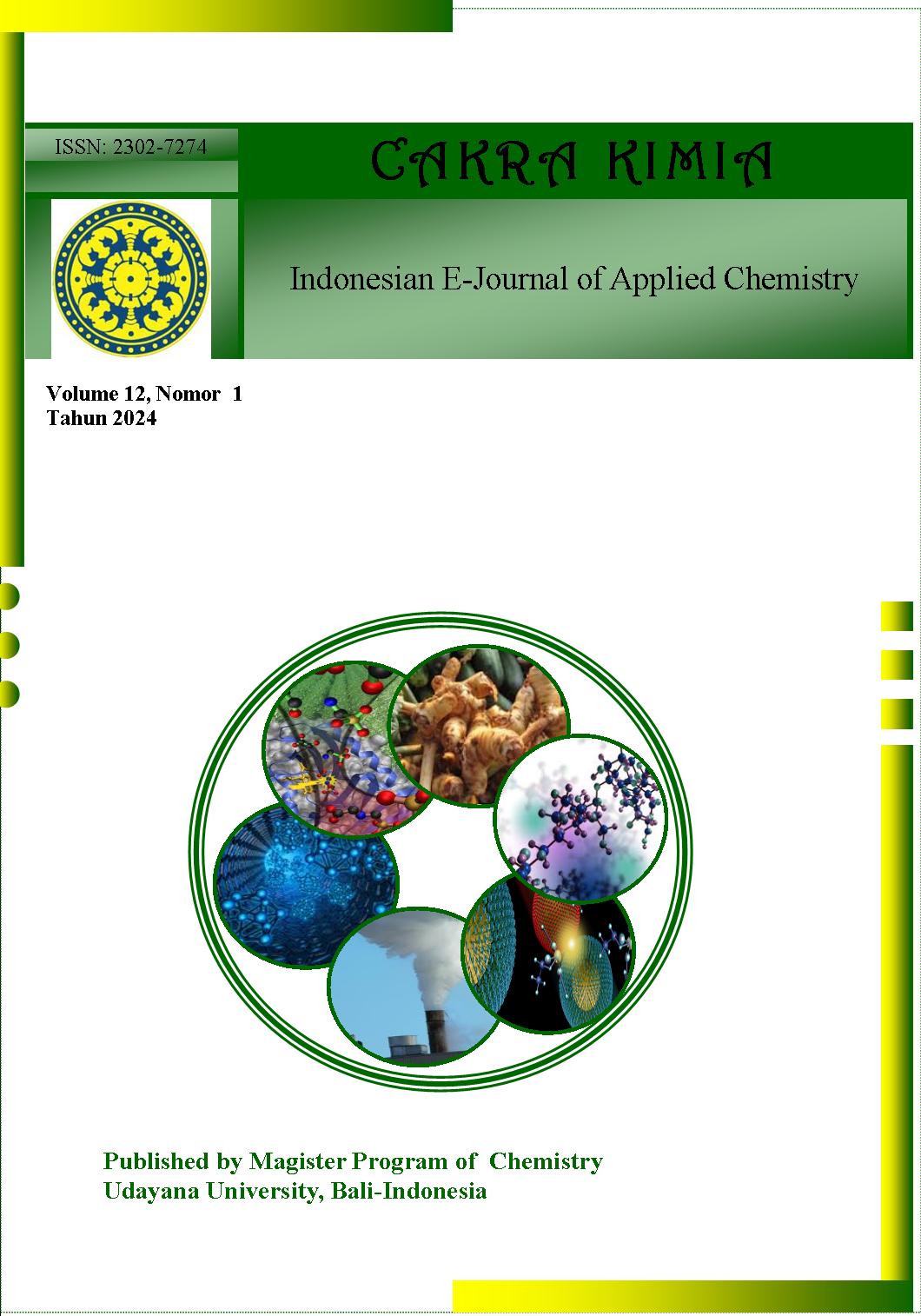GEOCHEMICAL SURVEY FOR DETERMINING GOLD CONTENT USING X-RAY DIFFRACTION METHOD IN GUNONG UJEUN OF KRUENG SABEE DISTRICT ACEH JAYA
Abstract
ABSTRAK: Survei geokimia dilakukan untuk mendeteksi kandungan dari berbagai jenis mineral yang ada. Identifikasi emas pada batuan dari lokasi penambangan emas rakyat di Gunong Ujeun, Krueng Sabee, Aceh Jaya telah dilakukan menggunakan metode X-Ray Diffraction (XRD). Pada penelitian ini, proses identifikasi mineral dilakukan pada beberapa lokasi di Krueng Sabee. Sampel batuan yang terkumpul diproses untuk mendapatkan bubuk berbutir halus yang sesuai untuk dianalisis. Selanjutnya sampel tersebut dianalisis kadar emasnya menggunakan alat X-Ray Diffractometer. Data pengujian menggunakan XRD kemudian dianalisis menggunakan aplikasi Match!3. Mineral utama yang diidentifikasi dalam sampel batuan termasuk kuarsa, illit, magnetit, zircon, albit, dan hastingsit. Mineral-mineral ini umumnya terkait dengan mineralisasi emas. Hasil analisis menunjukkan bahwa kandungan emas tertinggi terdapat pada lokasi BT-02 dengan kadar 1,746% dan lokasi terendah yaitu lokasi BT-04 dengan kadar 0,029%. Pengujian dilakukan menggunakan Cu-Ka dengan panjang gelombang 1,542 Å. Hasil akhir tersebut diinterpretasikan dalam bentuk peta kadar emas.
ABSTRACT: Geochemical surveys have been conducted to detect the content of various types of minerals. The identification of gold in rock from the traditional gold mining in Gunong Ujeun, Krueng Sabee, Aceh Jaya using X-Ray Diffraction (XRD) method has been carried out. In this study, the mineral identification process was conducted at several locations in Krueng Sabee. The collected rock samples were processed to obtain fine-grained powder suitable for analysis. Subsequently, the gold content in the samples was analyzed using X-Ray Diffractometer. The XRD data were then analyzed by Match!3 software. The main minerals identified in the rock samples included quartz, illite, magnetite, zircon, albite, and hastingsite. These minerals are commonly associated with gold mineralization. The results indicate that the highest gold content was found in sample BT-02 at 1.746%, while the lowest was in sample BT-04 at 0.029%. The test was conducted using Cu-Ka with a wavelength of 1.542 Å. The final results was interpreted as a gold grade map.
Downloads
References
[2] Chaussier, J. B., Morer, J. Mineral Prospecting Manual. North Oxford Academic Publishers Ltd. London, 1987.
[3] Cheng, Q. Singularity theory and methods for mapping geochemical anomalies caused by buried sources and for predicting undiscovered mineral deposits in covered areas, Journal of Geochemical Exploration, 2012, 122, 55–70,
doi: 10.1016/j.gexplo.2012.07.007.
[4] McClenaghan. Drift Exploration in Glaciated Terrain. The Geological Society London. London, 2001.
[5] Marjoribanks, R. Geological Methods in Mineral Exploration and Mining. Springer. Berlin, 2010.
[6] Xuegju, W., Bimin, Z., Xin, L., Shanfa, X., Wensheng, Y., Rong. Y. Geochemical challenges of diverse regolith-vovered terrains for mineral exploration in China, Ore Geology Reviews, 2016, 73 (3), 417–431
doi: 10.1016/j.oregeorev.2015.08.015.
[7] Zuo, X., Wang, J., Xiong, Y., Wang, Z. The processing methods of geochemicl exploration data: past, present, and future, Applied Geochemistry, 2021, 132, 105072 doi: 10.1016/j.apgeochem.2021.105072.
[8] Chen, J. S., Liu, C. W., Lai, G. X., Ni, C. F. Effects of mechanical dispersion on the morphological evolution of a chemical dissolution front in a fluid-saturated porous medium. Journal of Hydrology, 2009, 373, 96–102,
doi: 10.1016/j.jhydrol.2009.04.014
[9] Carreno, J. L. M. Geochemistry applied to the exploration of mineral deposits, Geochemistry and Mineral Resources, IntechOpen Limited, London, 2022.
[10] Haritha, K. A review of recent advancements in geophysical technologies and their implications for mineral and hydrocarbon exploration, ASEAN Journal fo Science and Engineering Materials, 2023, 2(2), 95–108
[11] Wu, L. M., Zhou, C. H., Keeling, J., Tong, D. S., Yu, W. H. Towards an understanding of the role of clay minerals in crude oil formation, migration, and accumulation, Earth-Science Reviews, 2012, 115, 373–386,
doi: 10.1016/j.earscirev.2012.10.001.
[12] Balaram, V. Current and emerging analytical techniques for geochemical and geochronological studies, Geological Journal, 2020, 1–60, 2020, doi: 10.1002/gj.4005.
[13] Kyser, K., Barr, J., Ihlenfeld, C. Applied geochemistry in mineral exploration and mining, Elements, 2015, 11(4), 241–246
doi: 10.2113/GSELEMENTS.11.4.241.
[14] Habashi, F. Gold – an historical introduction, Gold Ore Processing, 2016, 1–20,
[15] Ismunandar, Hunter, B. A., Kennedy, B. J. Cation disorder in the ferroellectric Aurrivillius phase PbBi2Nb2O9: an anomalous dispersion X-ray diffraction study. Solid State Ionics, 2006, 112, 281–289
doi: https://doi.org/10.1016/S0167-2738(98)00222-7.
[16] Balaram, V., Subramanyam, K. S. V. Sample preparation for geochemical analysis: strategies and significance, Advances in Sample Preparation, 2022, 1, 100010
doi: 10.1016/j.sampre.2022.100010
[17] Pratapa, S. Difraksi Sinar-X. Institut Teknologi Sepuluh November, Surabaya, 2004.
[18] Epp, J. X-ray diffraction (XRD) techniques for materials characterization, Materials Characterization Using Nondestructive Evaluation (NDE) Methods, 81–124, 2016, doi: 10.1016/B978-0-08-100040-3.00004-3
[19] Jacques, M. In Situ Tests in geotechnical Engineering, ISTE-Wiley, London, 2015.
[20] Jalil, Z., Sari, K., Safitri, R. Mineral composition in rock from gold mining areas at Gunong Ujeun Krueng Sabee Aceh Jaya, Jurnal Natural, 2013, 13 (1), 15–18



 Petunjuk Penulisan
Petunjuk Penulisan
